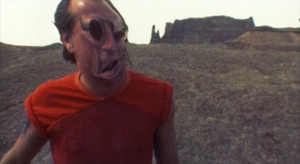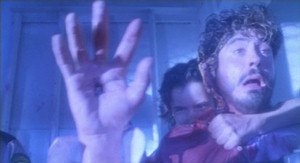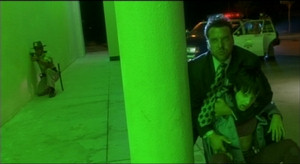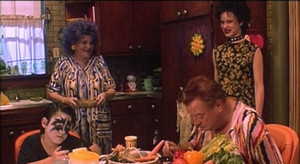Natural Born Killers
In announcing the Trashy Movie Celebration Blog-a-thon (happening here the weekend of April 6 through 8), Neil of The Bleeding Tree appeared to include only one standard beyond the guidance provided by the name itself:
“I don’t want to hear about Tod Browning, Sergio Leone, Paul Verhoeven, Quentin Tarantino […] . All of them have a substantial base of critical and popular support.” (Emphasis added.)
So let me say at the outset: Neil, I’m violating your sorry-ass rule. The movie I’ve chosen was directed and co-written by a filmmaker with a “substantial base of critical and popular support.” And the story originated with one Quentin Tarantino.
Despite (and because of) its pedigree, Natural Born Killers is undoubtedly trashy, reveling in the killing spree of Mickey (Woody Harrelson) and Mallory (Juliette Lewis) and joyfully joining in the public and media fascination with mass murderers. And it’s an invigorating, brilliantly assembled movie celebrating the way that cinema can make the ugliest human behavior thrilling.
(This blog-a-thon is a ridiculous exercise in which one must first justify calling something “trash,” and then make an argument for it – without reservation or caveat – as important, relevant, worthwhile, or artistic. A comparison: “You are a whore. But you’re such a good whore that you’re not really a whore at all, but a professional sex artist.”)
To start, let’s dispense with Oliver Stone’s vision of Natural Born Killers.
The director has repeatedly called the movie a satire, and he continues to claim it was grossly misunderstood. In a 2002 interview, he said:
“To my mind, almost everything that was important about Natural Born Killers was overlooked amid all that hysteria over the death toll, and all the nonsense about whether or not I was promoting violence or instigating murder. […] Natural Born Killers was never intended as a criticism of violence. How can you criticize violence? Violence is in us – it’s a natural state of man. What I was doing was pointing the finger at the system that feeds off that violence, and at the media that package it for mass consumption.”
The irony, of course, is that Natural Born Killers is nothing if not violence packaged for mass consumption. Like a pacifist who agrees to a bare-knuckle brawl with a barroom bruiser, Oliver Stone lost his battle with media violence before it even began by engaging the enemy using the enemy’s weapons.
It’s not that violence can’t be an effective tool for commenting on violence. A movie such as Funny Games operates by forcing the viewer to interact with filmed violence intellectually rather than viscerally, with its sober tone and through cinematic techniques such as characters directly addressing the camera, and the way the director remains fixated on the face of a victim as she’s forced to strip. The audience is made painfully aware of the horror it sees because there is no entertainment value.
Natural Born Killers conforms to the technical requirements of satire – it is obviously parodic and mimics that which it faults – but it never fosters that critical distance in the audience. There’s one real moment of self-awareness in the movie – when Mallory notes, “I think we’re the demons” – and Nine Inch Nails’ contemplative, minor-key “Something I Can Never Have” offers a small measure of sadness and regret. But those are anomalies, overwhelmed by the giddiness in the filmmaking.
When I saw the movie in the theater in 1994, it exhilarated me. A long-form music video, Natural Born Killers is a triumph of form over content, a dumb and largely plotless work loaded with sleazy, one-note characters and over-the-top performances. But it’s driven by an aggressive, stream-of-conscious, any-shot-that-looks-good style that devours whatever message the filmmaker hoped to impart. Different film stocks, video, stock footage, and animation mingle freely and without narrative purpose, and the freewheeling aesthetic is furthered through the regular use of split-second inserts that seem to originate in the subconscious of Mickey and Mallory.
The audience is drawn into the Stone’s gorgeously rendered surfaces – unconventional angles, an electric key-lime green, the straightforward fury of L7’s muscular “Shitlist” matched with a scene of diner carnage – and is mesmerized by the kinetic editing and bracing juxtapositions. The viewer gets lost in visual delights, to the point that the content of the images becomes irrelevant. Stone creates continuous coarse beauty in Natural Born Killers, undermining his purpose.
There’s only one scene in which Stone matches technique with function: the inspired faux sitcom that depicts the beginnings of the romance of Mickey and Mallory – complete with laugh track, Rodney Dangerfield, profanity, and references to molestation. Pointed and prescient, the bit finds the director looking forward and seeing a reality-TV future in which audiences derive entertainment from abuse and suffering. Critical to the episode’s success is its visual approach, employing the puke-y colors and the cheap look of video to underscore the ugliness of what’s happening.
I don’t mean that as a criticism of the remainder of the film. Natural Born Killers’ failure as a screed against media violence doesn’t make it a bad movie, just one that’s different from what Stone intended. Authorial intent should not be discounted, but it has to be balanced by the way viewers react to and interpret the work. Movies are a form of communication, but sometimes that communication is between the text and its consumers, rather than between the primary author and the audience. This is a movie with a life far beyond what Stone planned.
The director’s striking images (and the bravura combinations of im
ages by him and his editors) are devoid of contextual meaning; they’re isolated from his aim. Much as pornography emphasizes anatomy, penetration, and ejaculation at the expense of eroticism, so does Natural Born Killers emphasize the art and poetry of the individual shot at the expense of Stone’s stated aim.
Yet, in a roundabout way, this proves his point. Natural Born Killers is not a celebration of bloodlust itself, but evidence of its own hypothesis that media portrayal of violence is alluring, addictive, and downright sexy. Stone gets his message across not by winning his righteous fight against media violence but by getting the shit kicked out of him. The enemy is powerful indeed.






I’m pleased someone made the effort to not take my rules too seriously… I’m not at all convinced, as it goes, that being “trashy” and being “trash” are the same, however.
Mostly, though, I’m annoyed that you may have hastened my revisiting of Natural Born Killers, which I had just said within the last week I had no interest in revisiting any time soon. Fine!
Neil:
It’s no effort at all to ignore rules. I’ve been doing it all my life.
I recognize that there’s some difference between being “trash” and being “trashy,” beyond their parts of speech. The former is a more damning and final judgment, but it seems like a minor distinction. I’m curious what you think the difference is.
And thanks for organizing and facilitating the blog-a-thon. It’s a great topic.
I think the key, as best I can say, is that “trashy” is not necessary analogous to a whore, but perhaps to any woman who dresses in a particular way. Dolly Parton, for example, puts a great deal of effort into dressing in a “trashy” way, but is clearly a sharp businesswoman and thoughtful in how she defines herself, not to mention a much more brilliant songwriter than she is given credit for.
In those terms, I see a trashy movie as one that puts it easily exploited and grungier elements in the forefront. In some cases, as with many women who dress in trampy clothes, this is because these are the only things it has to offer. In others, it may be because it is, or was felt to be, the best way to find an audience… or perhaps the filmmakers found the blending of the two seemingly disparate elements to be, in itself, an interesting part of the aesthetic or statement they were attempting to achieve.
Neil:
I don’t think the Dolly Parton analogy works, but otherwise you’ve clarified your distinction for me.
In the case of Natural Born Killers, though, I think it qualifies as both trashy and trash, and in my mind that undermines your definitions somewhat. It is not valueless, but its value is less in the text itself than in the way the text shows the perils of being trashy, no matter one’s intent. Stone succumbed to that which he hates and (seemingly by accident) proved his point.
Great piece!
Looking at it again, Natural Born Killers is a great grindhouse type movie. It was misunderstood because no one enjoyed the subject matter or took it as it was to be taken – as satire. I remember seeing it with some friends and laughing out loud when the blood ran down the screen because it was so obvious that it was so extreme that there was no way it could be taken seriously. All I got was disturbed looks from everyone.
Imagine if everyone would have hooted and hollered during that movie.
I will have to admit that once I saw it again on video, it disturbed me more. It seemed more evil on the smaller screen. I have thought of it often, but not seen it since.